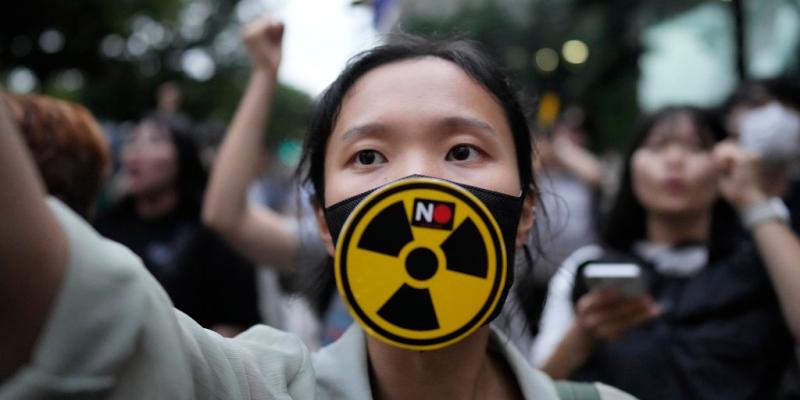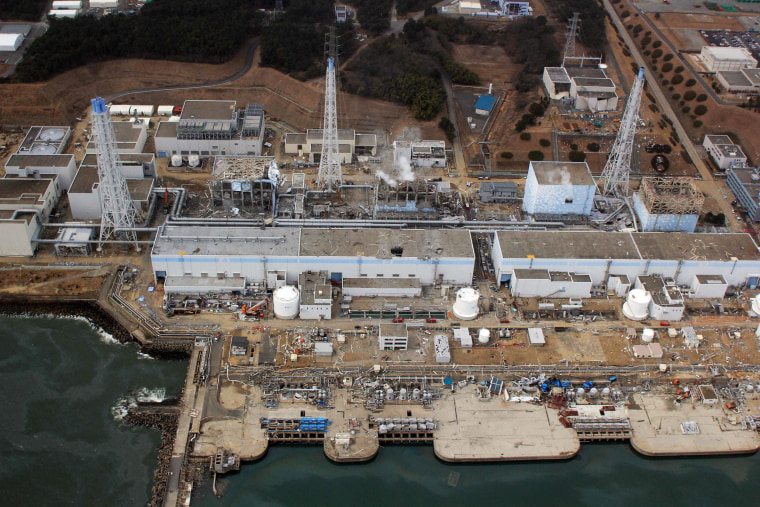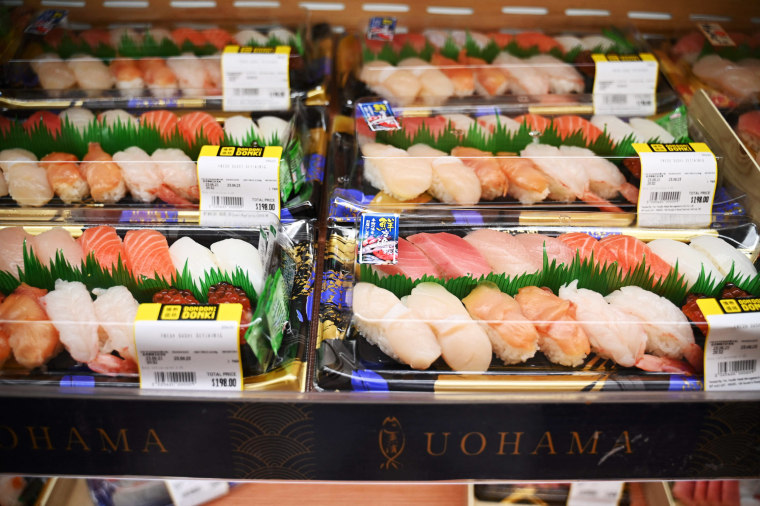Japan releases water from Fukushima nuclear plant into the ocean
Category: News & Politics
Via: perrie-halpern • 2 years ago • 17 commentsBy: Larissa Gao and Cheng Cheng



Japan began to release treated radioactive water from the wrecked Fukushima nuclear plant into the ocean on Thursday, amid opposition from some domestic activists and loud objections from neighboring countries including China.
The gradual discharge of an estimated 1.3 million metric tons of wastewater from the destroyed Fukushima Daiichi nuclear power plant into the Pacific Ocean began around 1 p.m. local time (12 a.m. Thursday ET), said the plant's operator, the Tokyo Electric Power Company (Tepco).
The whole process is expected to take about 30 years to complete.
The plan has been approved by Japan's government and the International Atomic Energy Agency, the United Nations' nuclear watchdog, which said in July that the release met international safety standards and would have "negligible radiological impact to people and the environment."
The process will allow the decommissioning of the plant more than a decade after a 9.0-magnitude earthquake and tsunami set off a meltdown that spewed radioactive particles into the air in the world's worst nuclear accident since the 1986 incident at Chernobyl.
The water — which is enough to fill 500 Olympic-size swimming pools and continuing to build — has been used to cool fuel rods inside the Fukushima plant's nuclear reactors since the 2011 meltdown and is now being held in about 1,000 storage tanks on site that Japan says are almost full. Though the water is filtered and diluted to remove most radioactive elements, it still contains low levels of tritium, an isotope of hydrogen that is difficult to strip out.
Officials say the levels of tritium in the water being released will be well below what is considered safe by the World Health Organization and that wastewater containing tritium is routinely released by nuclear plants around the world, sometimes at higher levels.

The damaged Fukushima Daiichi nuclear plant in Okuma, Japan, in 2011. AFP - Getty Images file
Despite Japan's efforts to reassure the public — Prime Minister Fumio Kishida visited the area last weekend to highlight the safety of the plan — it has been beset by criticism from Japanese fishing groups who fear the impact on their livelihoods as well as environmental activists and some scientists who say the full extent of the risks remains unknown.
Tepco has also been accused of a lack of transparency, although it has vowed to put safety first and apologized for causing concerns.
"There are a lot of uncertainties there because of the limited data we can access," said Wu Shiu-sun, a marine scientist at the Education University of Hong Kong. "We don't know how much water is actually going to be discharged and how long exactly the plan will continue."
The release has also become a political and diplomatic issue, especially in countries with whom Japan has a historically fraught relationship.
Leading the criticism is China, the biggest importer of Japanese seafood. At a briefing Wednesday, Wang Wenbin, a spokesperson for the country's foreign ministry, said that releasing the radioactive water "blatantly transfers the risk of nuclear pollution to neighboring countries including China and the international community, and puts self-interest above the long-term well-being of the people in the region and around the world."
China has extended a longstanding ban on seafood imports from 10 of Japan's 47 prefectures, including Fukushima and Tokyo, the capital. Officials said last month they would also increase scrutiny of food imports from the prefectures that are not banned.
Similar measures take effect Thursday in the Chinese territory of Hong Kong, the second-biggest market for Japanese seafood after mainland China.
Hong Kong's top leader, John Lee, said the water release was an "irresponsible act" that "has blatantly ignored the inevitable risk on food safety and the irreversible contamination and damages to the marine environment."
Hong Kong resident Samantha Ku said she buys Japanese seafood a few times a week but she might stop eating it as a result of the decision to release the water.
"It's about safety," Ku, 40, said Wednesday. "It would affect us, affect our health and body."
Jimmy Cheng, owner of a Japanese restaurant in Hong Kong called Superdon, said he was concerned that his customers "might be worried about eating Japanese food."
Cheng, 34, said convincing customers would be "another challenge" for restaurants like his, which are already struggling as Hong Kong tries to revive tourism after three years of pandemic isolation.

Fish from Japan at a supermarket in Hong Kong on Wednesday.Peter Parks / AFP - Getty Images
The South Korean government reiterated this week that it sees no scientific or technical issue with plans to release the water.
"If by any chance Japan veers from its original discharge plan, the South Korean government will deem this action harmful to the safety and health of the South Korean people and request Japan to cease all operations immediately," Park Ku-yeon, the first deputy chief of the Office for Government Policy Coordination, said at a news briefing in Seoul on Tuesday.
Despite government assurances that it will closely monitor the release and test seafood for radiation, the South Korean public has expressed high levels of anxiety over the plan. The country's majority opposition party and civic groups have held protests around the country, including on Wednesday.
Cook Islands Prime Minister Mark Brown, the chair of a forum of 18 Pacific island nations, said in a statement on Wednesday that while he believes the discharge meets international safety standards, other Pacific leaders may disagree.
Experts say a lot of time and study has gone into the process.
"This is not a decision or set of steps that are happening in haste by any means, and this is a practice that is common and consistent around the world and with the nuclear energy industry," said Marina Lorenzini of the Belfer Center for Science and International Affairs at the Harvard Kennedy School of Government.
She added that the IAEA's active engagement in the process "makes me feel a lot more comfortable and confident with the events we see playing out today."
The IAEA said this week that it would maintain an onsite presence at the Fukushima plant, where it opened an office last month, and publish real-time and near real-time monitoring data.
"I think we have good reason to believe that this will be a well-monitored and well-maintained operation," Lorenzini said.

Tags
Who is online
82 visitors

meh, probably nothing to be too concerned about...
Oh no, there goes Tokyo
Go go Godzilla, yeah
In the 1998 movie Godzilla the monster that attacked New York City had mutated and developed because of nuclear waste in the ocean. Hopefully one that Japan may have created will turn on the nation that may be the cause of such a creature.
Oh, there you go again Buzz - you just watch too many movies.
Partied with BOC way back in the day.
I’m sure this is fine.

I’m sorry, but that is a measurement that means nothing to most people. Can I get that converted to swimming pools?
That is funny but if you want a real value,
so take that times 1.3million and you get 343,423,600 gallons. 1 cubic foot of water is about 7.5 gallons so an olympic size pool would be approximately 614,500 gallons. So you are talking about 558 Olympic pools (base on a 6' average depth)
Thank you.
Given the absolute reliance upon the ocean as the major food source (outside of rice) for Japan, this must be unsettling for those folks no matter what assurances are provided by authorities.
What with God already hating them, scallops are in for a real bad time.
I foresee a huge bonanza marketing to pearl clutchers that need therapeutic benefits...
Wow! Think of it - pearls that glow in the dark.
Oh no!!! There is a seafood kiosk in the mall below - I can see it from my balcony, and I frequent it because I LOVE scallops. The dressed lightly grilled scallops on the half shell in this photo I took there sell 5 for the equivalent of US$2, i.e. just 40 cents each. Now, if I ask them where they come from I'm sure they won't say Japan if they do, so now I'm going to be deprived of a delicacy.
Arvo..we have scallops..lots and lots of them...
But I don't think we will be selling them to China anytime soon so you will be stuck with the Japanese ones..
I can send you over the empty shells if you like..last I saw they sell for $2 each here nice fat juicy ones..one of my favourite seafoods..
I think the Japanese ones may be three times the size and have a certain glow to them.
Eventually they might mutate to big enough to eat us.
I think that if the Japanese officials who support the release of the contaminated water and the officials of the IAEA who okayed it should prove their position by swimming every 6 months from now on at the beaches nearest the point of release. If they refuse, then it will be like the negotiator from PG&E who passed on drinking a glass of water from the area they contaminated in the movie Erin Brockovich.
I’m not sure what else anyone thinks they can do with it. It will take 30 years just to release it. The containment vessels aren’t going to last as long as the radiation will.